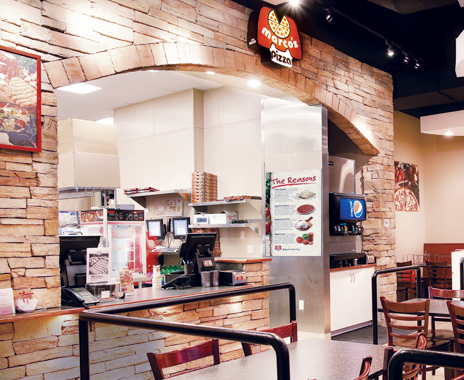As president of Ohio-based Marco’s Pizza, Bryon Stephens oversees a 600-unit chain poised to add 175 units this year. That rapid growth provides Stephens dynamic insight into one of the more pressing problems facing today’s growth-focused quick-service brands: real estate.
“To label [today’s real estate climate as] competitive isn’t quite accurate, because it’s more than competitive,” Stephens says, adding that the topic now dominates boardrooms and franchise shows. “Top-quality sites have been sucked up into the vortex, and what’s left in many markets is low-quality or overpriced.”
The competitive environment, Stephens and other quick-service leaders say, extends beyond the hot growth areas and prime suburban sites blanketed with Millennials, soccer moms, and high disposable incomes. Even secondary and tertiary markets where landlords and developers relish holding the upper hand have become incredibly competitive.
“You just can’t escape the competition,” says Greg Goddard, director of development for the 300-unit Penn Station East Coast Subs. “Across the board, we’re seeing higher costs and more people vying for space because so many concepts are trying to grow at the same trajectory.”
International Council of Shopping Centers (ICSC) spokesman Jesse Tron calls today’s commercial real estate climate “hyper competitive” with apparel retailers, day cares, bike shops, and more battling restaurants for available real estate.
“Retailers are healthy and looking for space, but demand is far outpacing supply,” Tron says. “As rental rates continue to increase, we could see more new developments on the horizon, but right now we’re largely in a phase of redevelopment, not new development.”
Real estate realities have forced quick-service chains to get creative with their real estate procurement.
“A lot of our development today has to be creative dealmaking, and you have to flip the coin over a lot to come up with a better solution,” says John Todd, chief development officer for Dallas-based Fiesta Restaurant Group, parent company for Pollo Tropical and Taco Cabana.
Flexibility, in fact, is at a premium as brands look to adjust their concept to account for real estate’s surge. Take the 220-unit Johnny Rockets chain. Recognizing that it could not land the growth it seeks solely through its legacy prototype in A-plus locations, the California-based company launched its Express and Route 66 prototypes, scaled-down store formats that champion efficiency and leverage technology to maximize kitchen output, restaurant throughput, and revenue per square foot.
“Our Express and Route 66 prototypes allow us to go where real estate is more available and more affordable,” says James Walker, Johnny Rockets president of operations and development.
Marco’s is traditionally a carryout and delivery spot that seeks 1,500–1,600-square-foot inline spaces—“The type of space all the sandwich chains and nail salons want,” Stephens says—but the brand has begun adding seats to many of its new locations to capitalize on larger sites where the competition isn’t as fierce. The pizza chain then adds dimensions and dayparts to boost revenue, such as expanded salad and sandwich menus, as well as beer and wine.
“This is real estate that wouldn’t have been in our portfolio before,” Stephens says. “It used to be that 10 percent of our stores had seats; now, 85–90 percent of our new builds include seats.”
Penn Station, meanwhile, invested in a custom-built analytical model to fuel its strategic market development and drive its flexibility. Typically focused on defined specs for its new units—namely 1,600–1,800-square-foot locations—Penn Station has become increasingly open to spaces of all different sizes and leans on an exhaustive data set to inform decision-making.
“In the past, we wouldn’t even look at a 1,400-square-foot space because we couldn’t get the seating we needed. Now, if that site has the demographics we want, we’ll certainly consider it,” Goddard says.
More than ever, quick-service leaders are also touting the value of strategic relationships, both with brokers and other businesses. Goddard and his Penn Station colleagues have worked to develop a deep and connected network of professional brokers with far-reaching, street-level intelligence, not merely a Multiple Listing Service username and password.
“The truth is that the best spaces rarely hit the open market, and the best brokers know that Starbucks is moving to a drive-thru unit down the street and its current storefront will soon be available,” Goddard says.
Co-tenancy is also gaining momentum; in fact, it’s a natural occurrence at the multi-concept Fiesta Restaurant Group, which will position Pollo Tropical and Taco Cabana as a package deal to gain negotiating leverage with landlords and developers.
“These folks see the advantages of putting two concepts on the same pad and only dealing with one point of contact,” Todd says.
Marco’s, meanwhile, continues to actively seek complementary concepts, such as frozen yogurt stops or coffee shops, to approach developers with as a co-tenant arrangement.







